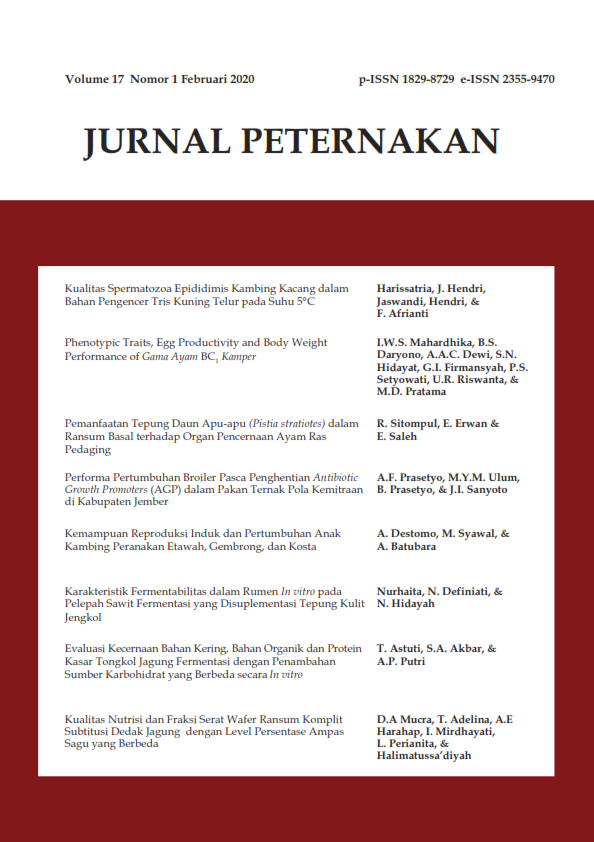Evaluasi Kecernaan Bahan Kering, Bahan Organik dan Protein Kasar Tongkol Jagung Fermentasi dengan Penambahan Sumber Karbohidrat yang Berbeda secara In vitro
DOI:
https://doi.org/10.24014/jupet.v17i1.8707Keywords:
Corn cob fermentation, source of carbohydrates, digestibility in vitroAbstract
This research aimed to evaluation the affect of corn cob fermented with Phanerochaete chrysosporium by adding the different sources of carbohydrates on the digestibility of dry matter, organic matter, and crude protein by in-vitro methods. The treatments were : P0 = fermented corn cobs without carbohydrate, P1 = fermented corn cobs + 10% rice bran; P2 = fermented corn cobs + 10% tapioca flour; P3 = corn cob fermented + 10% molasses, and using a compleately randomize design for varian analize. The resulted of this study shown a very significant affected (P <0.01) on the digestibility of dry matter and organic matter but no affected (P> 0.05) on crude protein digestibility. The best results digestibility of dry matter (66.98%) on the P3 treatment adding molasses, and the highest digestibility of organic matter (67.49%) on the P3 treatment too, but the highest digestibility of crude protein (51.37%) in P1 treatment (adding by rice bran).
References
Faesal. 2013. Pengolahan Limbah Tanaman Jagung Untuk Pakan Ternak Sapi Potong.Seminar Nasional Inovasi Teknologi Pertanian. Balai Penelitian Tanaman Serealia.Jawa Timur.
Imsya, A., E. B. Laconi, K. G. Wiryawan, & Y. Widyastuti. 2014. Biodegradasi lignoselulosa dengan Phanerochaete chrysosporium terhadap perubahan nilai gizi pelepah sawit. Jurnal Peternakan Sriwijaya. 3(2): 12-19.
Maeng, W. J., H. Park, & H. J. Kim. 1997. The Role of Carbohydrate Supplementation in Microbial Protein Synthesis in Rumen. In Onedera, R.H, Itabashi, K. Ushida, H. Yano and Y. Sasaki. Rumen Microbes and Digestive Physiology in Ruminants. Japan Scientific Societies Press. Tokyo.
Murni, R., Suparjo, Akmal, & B. L. Ginting. 2008. Buku Ajar Teknologi Pemanfaatan Limbah Untuk Pakan. Laboratorium Makanan Ternak Fakultas Peternakan. Universitas Jambi. Hal. 37. Jambi.
Prastyawan R. M., B. I. M. Tampoebolon, & Surono. 2012. Peningkatan kualitas tongkol jagung melalui teknologi amoniasi fermentasi (amofer) terhadap kecernaan bahan kering dan bahan organik serta protein total secara in vitro. Animal Agriculture Journal. 1(1): 611621.
Rahman, A. 1992. Teknologi Fermentasi. Pusat AntarUniversitas Pangan dan Gizi, Institut Pertanian Bogor. Bogor.
Steel, R. G. D., & J. H. Torrie. 1991. Prinsip dan Prosedur Statistika Suatu Pendekatan Biometrik. Cetakan ke-4. Diterjemahan oleh : B. Sumantri. PT. Gramedia Pustaka Utama. Jakarta.
Tilley, J. M. A., & R. A. Terry. 1963. A Two Stage Technique for the In vitro Digestion of Forage Crops. Journal of British Grassland. 18: 104-111.
Widayati, E., & Y. Widalestari. 1996. Limbah untuk Pakan Ternak. Trubus Agrisarana, Surabaya.
Winarno, F. G., & S. Fardiaz. 2003. Pengantar Teknologi Pangan. Jakarta. Penerbit PT. Gramedia.
Van Soest, P. J. 1982. Nutritional Ecology of Ruminant : Ruminant Metabolism, Nutritional Stategies, the Cellulolytic Fermentation and The Chemistry of Forages and Plant Fibers. Cornell University Press. Ithaca.
Downloads
Published
Issue
Section
License
The Authors submitting a manuscript do so on the understanding that if accepted for publication, copyright of the article shall be assigned to Jurnal Peternakan and published by Fakultas Pertanian dan Peternakan Universitas Islam Negeri Sultan Syarif Kasim Riau as publisher of the journal.
Authors who publish with this journal agree to the following terms:
Authors automatically transfer the copyright to the journal and grant the journal right of first publication with the work simultaneously licensed under a Creative Commons (CC BY) that allows others to share the work with an acknowledgement of the work's authorship and initial publication in this journal.
Authors are able to enter into separate permission for non-exclusive distribution of the journal's published version of the work (e.g., post it to an institutional repository or publish it in a book), with an acknowledgement of its initial publication in this journal.
Authors are permitted and encouraged to post their work online (e.g., in institutional repositories or on their website) prior to and during the submission process, as it can lead to productive exchanges, as well as earlier and greater citation of published work (See The Effect of Open Access).

